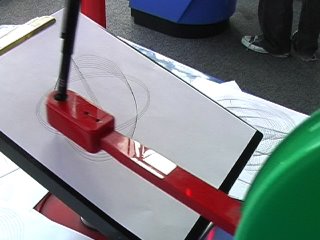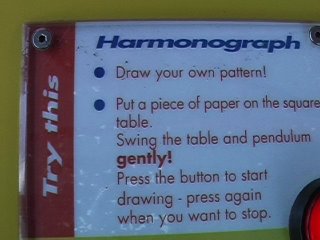Techniquest Visit

The Harmonograph
A harmonograph is a mechanical device that employs pendulums to create a picture. The drawings created by the machines can be Lissajous curves or even more complex. The devices appeared in the 19th century and are attributed to Jules Antoine Lissajous.
A simple harmonograph uses two pendulums to control the movement of a pen relative to a drawing surface. One pendulum moves the pen back and forth along one axis and the other pendulum moves the drawing surface back and forth along a perpendicular axis. By varying the frequency of the pendulums relative to one another (and phase) different patterns are created, Even a simple harmonograph as described can create ellipses, spirals, figure eights and other Lissajous figures.
More complex harmonographs incorporated three or more pendulums or linked pendulums together
From Wikipedia: http://en.wikipedia.org/wiki/Harmonograph




The chosen device generates a visual image produced by the movement of a weighted pendulum and table that swings smoothly to produce a high volume of curved lines that creates an interesting high detailed pattern.
At first glance the device seems very peculiar as it contains a very large metal object holding a small pen. The pen is raised about 2 to 3 inches above a small table slightly larger than A4, with a large silver clip. The Harmonograph has instructions that allow the device to be easily used.
The displayed instructions are:
1 Draw your own pattern
2 Put a piece of paper on the square table
3 Swing the table and pendulum GENTLY!
4 Press the button to start drawing – press the button again when you want to stop

When using the Harmonograph I noticed I didn’t swing the small table, I seemed drawn to the large pendulum that seemed to be the focus of the device. Observing the children I noticed only one out of four actually moved the table and the pendulum. This stands out as an interesting focus of design. As the simplicity of color and scale can alter the way in which an interactive device can be used and misused producing the wrong affect. After having an group discussion with Sue Cavell (Head of Research and Evaluation at Techniquest) Sue stated very clearly that the target age group for the design of the devices shown at Techniquest is of 12 years old, Sue moved on to say the devises are produced to the height and reach of a child at the age of 12.
The device produces a very interesting pattern that is produced as hard copy (on paper) that can be taken away to reflect on at a later date. I wouldn’t look at the Harmonograph as entertaining but a more interesting device. Observing the children I noticed they where not very interested in the device as there where many others more astheticaly pleasing in the nearby surounding. But all the children that did visit the Harmonograph interacted with the device mainly moving the large metal pendulum, but seemed to quickly lose interest with the paper and metal clip.

<< Home